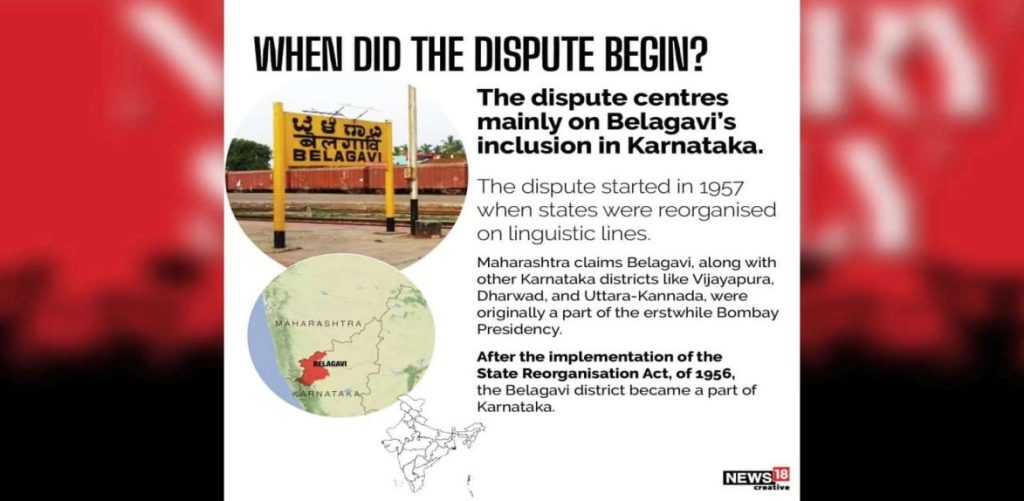23 Dec Karnataka and Maharashtra Border Dispute
Karnataka and Maharashtra Border Dispute
The article talks about how the Dispute on the border between Karnataka and Maharashtra impacts Indian Polity and Governance- Constitution and this topic is related to daily current affairs for the UPSC examination.
Relevance For Prelims: laws and authorities governing the creation of new states or the redrawing of existing ones
Relevance For Mains: Inter-state border disputes, GS-2
In News: Recently, the conflict between Maharashtra and Karnataka over territory that both States contend is theirs has gotten unpleasant, vociferous, and even violent.
The Genesis of the Karnataka and Maharashtra Border Dispute
- The State Reorganisation Act of 1956, which reorganized states along linguistic lines, is when the Maharashtra and Karnataka boundary conflict began.
- Madras Ekikaran Samiti (MES): The Maharashtra Ekikaran Samiti (MES) was founded in 1948.
- A petition by the Maharashtra government demanding 865 villages from five Karnataka districts and contesting various aspects of the State Reorganisation Act, 1956 Belagavi, Karwar, Vijayapura, Kalaburagi, and Bidar are the five districts.
High levels of tension exist in Karnataka, particularly in the district of Belagavi, which borders Maharashtra
Karnataka’s perspective: The distinctions started when Mysore changed its name and established the State of Karnataka As soon as the neighboring Bombay state, later renamed Maharashtra, and Mysore state, afterward renamed Karnataka, were founded on November 1, 1956, disagreements broke up.
Maharashtra’s perspective: Maharashtra believed that the Belagavi district of Karnataka, in the state’s northwest, should be a part of it. This belief sparked a decade-long, violent agitation that resulted in the formation of the Maharashtra Ekikaran Samithi (MES), which continues to rule over some areas of the district and the city bearing its name.

Karnataka and Maharashtra border dispute
Union Government’s stand:
- In 1966, the Union government established a Commission: On October 25, 1966, the Union government established a commission headed by former Supreme Court judge Justice Meharchand Mahajan amidst protests and pressure from Maharashtra. The chief ministers of Maharashtra and Karnataka at the time were VP Nayak and S Nijalingappa, respectively.
- A report that reached an agreement on the consolidation of towns and villages: It was anticipated that the report would resolve the conflict and serve as a legally binding document for both states. In its report, which was turned in by the committee in August 1967, it was suggested that 264 Karnataka towns and villages, including Nippani, Nandgad, and Khanapur, and 247 Maharashtrian villages, including South Solapur and Akkalkot, be merged with Maharashtra.
The report was presented in 1970, but no action was taken because it became a poll question: Despite being presented to the Parliament in 1970, the report was not discussed. The demands for Kannada-speaking regions to join Karnataka and Marathi-speaking regions to join Maharashtra both grew without the recommendations’ adoption. In numerous areas of Belagavi,
- MES made it a campaign issue and won a series of elections from district constituencies.
Bilingualism A crucial component:
- Language influence: Thousands of Marathi terms have Kannada roots, and a comparable number of Kannada words have absorbed Indo-Aryan roots through Marathi.
- Both castes and communities on either side of the disputed line have extended families dispersed on both sides of the border.
- Harmonious cross-cultural exchange: For the past 120 years, Miraj town in Maharashtra has produced all of the harmoniums and sitars used by the best vocalists from Karnataka.
- Influence of the Bhakti movement on one another: In the past, Tukaram’s bhajans entered the hearts of Kannada speakers with the same ease that Basaveshwar’s saint-followers’ vachanas did so in the minds of Marathi speakers.
The current state of the dispute:
- The Maharashtra government petitioned the Supreme Court in 2004 to stake its claim over Marathi-speaking areas in Karnataka, which disputed the allegation.
- Taking advantage of popular feeling, Karnataka renamed Belgaum Belagavi and designated it as the second capital of the state.
- Both Karnataka and Maharashtra believe that a judicial solution is necessary because the complex problem cannot be resolved politically.

Inter-state border disputes
Concerns of Karnataka and Maharashtra Border Dispute
- The border conflict has been exploited by Maharashtra and Karnataka to inflame regional feelings ahead of elections.
- The boundary dispute is mentioned in every political party’s election platform in Maharashtra.
- Even the governor’s yearly speech to the joint meeting of the state legislative assembly and council mentions it.
- The Maharashtra-Karnataka boundary dispute has brought together political parties in Maharashtra, despite their ideological disagreements.
Source:
Daily Current Affairs for UPSC
Get the latest and updated current affairs for the IAS examination from Plutus IAS free of cost. It is the best coaching center for PSIR Optional. Also, read moderated and the best daily, weekly, and monthly current affairs for UPSC exam preparation.
Download the PDF Now:



No Comments